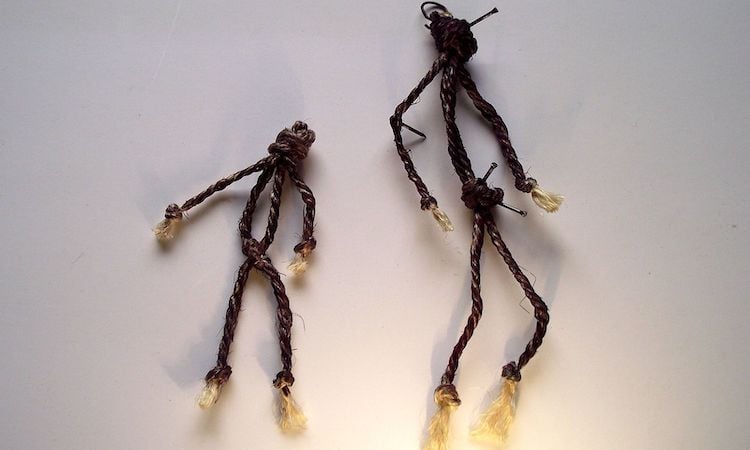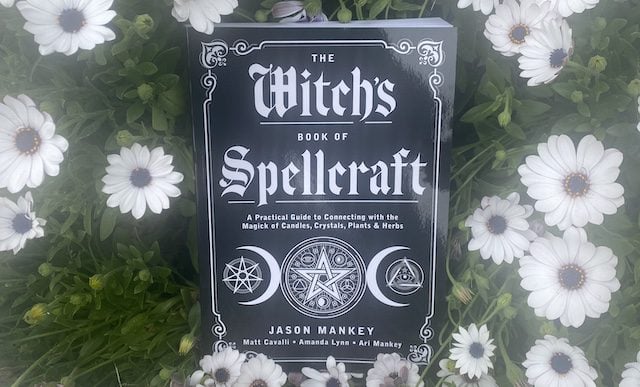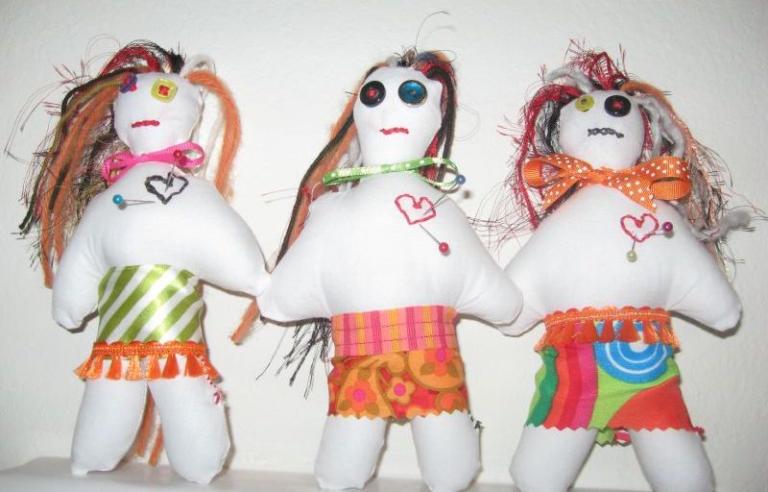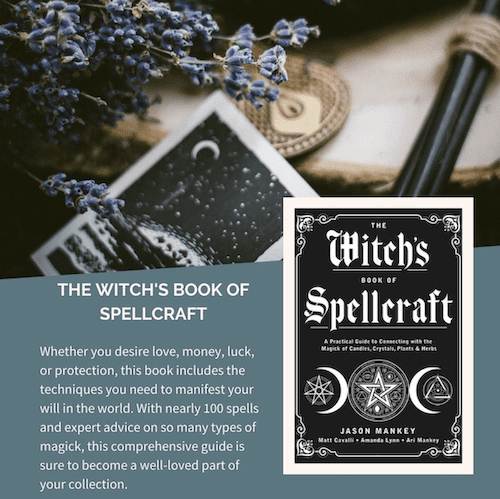In Great Britain, the term poppet is a term of endearment, most often directed at children. If the word poppet seems similar to puppet, that’s not a coincidence. Poppet is a Middle English term for puppet, and when not being used as a term of endearment, poppet pops up most exclusively in magickal settings.
To put it simply, a poppet is a puppet used for magickal purposes. Poppets don’t have moving mouths, but they are usually made to appear vaguely humanlike. Poppets are almost exclusively used to represent a specific individual (including oneself) or ideal. Poppets are often associated with negative forms of magick. The ubiquitous “Voodoo doll” is a type of poppet because it’s easy to direct one’s wrath into a doll that represents a specific person. But poppets can also be used for healing and other more benign practices.

In magickal practice, the most common form of poppet is one that resembles a stuffed animal. A pattern is drawn on two pieces of cloth, then the pieces of cloth are cut out and sewn together and the poppet is stuffed with a variety of magickal materials. This is the image most of us think of when we hear the word poppet, but a poppet can really be anything that represents a specific person (or thing). A piece of wood with a hand-drawn face and some glued-on yarn for hair is a poppet too. So if you don’t like sewing, you could make poppet corn dollies or poppets from sticks. Heck, you could even use a toy doll as your poppet if you really wanted to.
For a poppet to work in the way it’s intended, there needs to be a connection between the poppet and the target of the magick. The most effective forms of connection are physical items, such as nail clippings, hair, blood, spit, or sexual secretions. If these aren’t available, an item touched by the person being represented by the poppet is a powerful second choice, as is a signature written by the target. Lastly, the old standbys—a name written on a piece of paper or a picture of the person are also acceptable.
Making your poppet resemble the target in some way strengthens the bond between poppet and person. If you aren’t an artist, you could always choose a color of cloth that has energies that resonate with the poppet’s purpose. Don’t want to sew? A poppet made from natural materials that will rot and fade away is a great way to do banishing magick. As the poppet decays, the target will fade away from the spellcaster’s life.
Poppets also benefit magickally from the time it takes to assemble them. Yes, you could make a cheap and simple poppet by gluing some googly eyes on a stick, but the magick is always stronger when we take time to build a spell.
Much of the magick within a poppet is the result of what’s stuffed into it. We suggest using the various things written about in this book: stones, dried herbs, used candle wax, oils, charms, and incense resins. If you’ve chosen not to create your poppet from fabric, you can glue or attach various magickal implements onto it for the same effect.
Sympathetic magick plays a role here, too, as you might want to stuff your poppet with things representative of your end goal. If you are trying to remove someone from your life or keep them from bothering you, fill your poppet with undesirable things that are symbolic of how the person’s presence is not wanted in your life. Sawdust comes immediately to mind as a cheap, light, and easy way to fill a poppet. If your poppet is about healing, you could stuff it with some moss (cooling) or cotton (comfort).
Because it takes a significant amount of time to construct and fill up a poppet, poppets contain a lot of energy from the Witch who creates them. If you were to create a poppet to get revenge against someone who has wronged you, you’d fill your poppet with all of your justifiable rage and anger while visualizing the end result of the magick you want to manifest. As you stuff the poppet, you would also add your specific energies to it. Chanting or stating your desires out loud while filling the poppet are other ways to fill your poppet with its specific purpose.
Every inch and fiber of a poppet has the potential to be magickal. Something as simple as thread color can add more of your energy to a poppet’s magick. Stitching a poppet together can be a meditative exercise, easily accompanied by a chant to infuse the poppet with even more energy. Not surprisingly, the final knots used to finish a poppet’s creation are one more chance to infuse the poppet with more magickal energy.
Poppets, because of their close relationship to specific individuals, are traditionally “breathed into” to awaken their power. Breath is sacred and contains within it the power of life. Many practitioners use a straw to breathe into their poppet in an attempt to push their breath deep into the poppet. If this technique appeals to you, then you should most certainly use it. However, simply moving close to your poppet’s mouth and whispering, “I now awaken you and your magick, my will be done!” while pushing your breath into its mouth should be more than enough to awaken the energy inside the poppet.
After the poppet has received your breath, it’s important to verbalize your intention so the magick within the poppet can be properly projected out into the universe. Saying something like this will work: “May this poppet bring justice to me and rectify the wrongs of (name of person)!” If you follow the Wiccan Rede, you might want to add some sort of caveat to the declaration, like this: “May this poppet bring justice to me against (name of person) while harming none.”

In most cases, the act of creating a poppet and then directing that poppet toward its specific goal will be enough to accomplish your magickal work. But poppets are also active conduits of magick, and continuing to interact with your poppet after its creation will strengthen your spellcraft. For instance, if you are doing a healing spell for a sick friend, picking up the poppet, whispering words of encouragement into it, and cradling it in your arms will transfer energy to your sick friend.
On the other hand, can you drive a pin or nail into a poppet in an attempt to hurt somebody? Yes, that’s a valid form of magick. We don’t expect the person you built the poppet for to writhe in pain the moment you jab the pin into their side, but the pin will most likely cause some sort of damage, either mental or physical. Of course it’s more effective to have a specific end goal in mind than to simply cause hurt. Laying your poppet on a piece of wood and then driving your pin through the poppet and into the wood while saying “I bind you from moving against me!” will yield better results.

When working a spell to curse, punish, or rid yourself of someone, you can do more than just stick pins and needles into your poppet. Lighting a red candle for justice and then dripping the hot wax on your poppet will unleash the powers of truth upon your target. Burying a cloth poppet (or throwing one into a compost bin) and allowing it to rot and decay will remove a negative person from your life. If your poppet is targeting a well-known liar, you might want to cover the poppet’s mouth with duct tape or wrap a cord or piece of fabric around the poppet’s mouth to stop them from talking.
If you are trying to separate a person who is a negative influence from a group of friends or coworkers, you could hang the poppet from a doorknob, symbolizing how that person will soon be twisting in the wind, isolated and alone. Some of these suggestions look and sound quite sinister but are largely symbolic. The over-the-top symbolism is used to drive home the point of the magick and to make the end goal clear. Before hanging a poppet, though, you might want to verbalize your intention to prevent anything too nefarious from happening.
Creating a Poppet in a Few Easy Steps
Follow these steps to create your own poppets.
1. Create a figure to represent the magick’s target. Traditionally poppets are made out of cloth and sewn together, but if that’s not possible, other options are available. As the poppet is assembled, infuse it with your personal energy.
2. Gather items to stuff into (or add to) the poppet. Everything added to the poppet should be symbolic of your end goal or resonate with its energy.
3. Stuff the poppet. There’s no right or wrong way to stuff a poppet. You can save your most important magickal “goodies” for the end or sprinkle them throughout. As you stuff your poppet, continually add your personal energy to it and verbalize or project your intention into it.
4. Stitch up and/or finish the poppet. As you near the end of the poppet’s creation, state again your intention for making it. When it’s done, you may want to hold and push your own personal energy and will into the poppet.
5. Breathe life into the poppet. Activate the poppet’s energy by breathing into it and awakening its power.
6. Use the poppet. Simply stating your intention one final time and directing the poppet to work your will is all that is needed to activate the spell. However, handling your poppet, whether that involves sticking it with jagged glass or giving it loving hugs, will add more power to it and more accurately direct its magick.
7. Dispose of the poppet. When your spell has come to pass, you should dispose of the poppet. You can simply bury the poppet or throw it in the trash, but a more ethical way of disposing of a poppet is by disassembling it (and this is an absolute must if your poppet was for healing or encouragement—what if the poppet falls into the wrong hands?). The most important parts to remove are the ones that connect your poppet to its target. If you added a stone or crystal to your poppet that you want to keep, be sure to cleanse that stone before using it again.
Find Jason Online
My Patreon Starts at Two Bucks!
The Witch’s Book of Spellcraft
The Horned God of the Witches
Transformative Witchcraft: The Greater Mysteries
The Witch’s Wheel of the Year: Circles for Solitaries, Circles, & Covens
Raise the Horns on Facebook Jason’s Twitter
Pictures Of Magickal Stuff
Witch With Books Podcast

The Horned God of the Witches
Transformative Witchcraft: The Greater Mysteries
The Witch’s Wheel of the Year: Circles for Solitaries, Circles, & Covens
Raise the Horns on Facebook Jason’s Twitter
Pictures Of Magickal Stuff
Witch With Books Podcast

The Witch’s Wheel of the Year: Circles for Solitaries, Circles, & Covens
Raise the Horns on Facebook Jason’s Twitter
Pictures Of Magickal Stuff
Witch With Books Podcast

Pictures Of Magickal Stuff


















